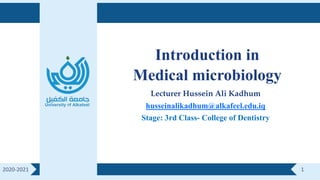
Introduction in Medical microbiology
- 1. 1 2020-2021 Introduction in Medical microbiology Lecturer Hussein Ali Kadhum husseinalikadhum@alkafeel.edu.iq Stage: 3rd Class- College of Dentistry
- 3. 1- chromosomes: a thread like structure of nucleic acids and protein found in the nucleus of most living cells, carrying genetic information in the form of genes. 2- pilus ( fimbria) : a series of threads Bacterial colonization involves multiple factors, including fimbriae or pili, flagella. 3- Ribosomes: a minute particle consisting of RNA and associated proteins, found in large numbers in the cytoplasm of living cells. They bind messenger RNA and transfer RNA to synthesize polypeptides and proteins. 4- Flagellum : a slender threadlike structure, especially a microscopic whip like appendage that enables many protozoa, bacteria, etc., to swim.
- 4. 5- Plasmid : a genetic structure in a cell that can replicate independently of the chromosomes, typically a small circular DNA strand in the cytoplasm of a bacterium or protozoan. Plasmids are much used in the laboratory .manipulation of genes. 6- Cell membrane : the semipermeable membrane surrounding the cytoplasm of a cell. 7- Cell wall : a rigid layer of polysaccharides lying outside the plasma membrane of the cells of plants, fungi, and bacteria. 8- Capsule or slime layer : is considered a virulence factor because it enhances the ability of bacteria to cause disease (e.g. prevents phagocytosis). The capsule can protect cells from engulfment by eukaryotic cells, such as macrophages. ... Capsules also contain water which protects the bacteria against desiccation.
- 5. 5 Bacterial Shapes, Arrangements, and Sizes Variety in shape, size, and arrangement but typically described by one of three basic shapes: 1- coccus - spherical 2- bacillus – rod 3- coccobacillus – very short and plump ( Brucella abortus) Streptobacilli ( Bacillus subtilus) diplobacilli spirillum - helical, comma, twisted rod, spirochete – spring-like- flexible ( Treponema pallidum) vibrio – gently curved ( Vibrio cholera) Spirilla- rigid ( Borrelia species) Pleomorphic : variable in shape ( Corynebacterium)
- 10. Bacterial Cell Structures & Functions Pili
- 11. Bacterial Cell Structure Appendages الزوائد flagella, pili or fimbriae Surface layers السطحية الطبقات capsule, cell wall, cell membrane Cytoplasm nuclear material, ribosome, mesosome, inclusions etc. Special structure endospore
- 12. Appendages 1. flagella Some rods and spiral form have this. a). function: motility b). origin : cell membrane flagella attach to the cell by hook and basal body e.g. E. coli G
- 13. Flagella Motility - movement Swarming occurs with some bacteria Spread across Petri Dish Proteus species most evident Arrangement basis for classification Monotrichous; 1 flagella Lophotrichous; tuft at one end Amphitrichous; both ends Peritrichous; all around bacteria
- 15. 2. Fimbriae and Pili Fimbriae: Shorter than flagella , smaller, hair like appendages . Only on some gram- bacteria. a). function: adhere. Not involve in motility. One of the invasive mechanism on bacteria. Some pathogens cause diseases due to this (Antigenic characteristic). Prevent phagocytosis.
- 16. pili - sex factor. If they make pili, they are + or donors of F factor. It is necessary for bacterial conjugation resulting in the transfer of DNA from one cell to another. It have been implicated in the ability of bacteria to recognize specific receptor sites on the host cell membrane.
- 17. Conjugation in E. coli
- 19. Capsules can serve numerous functions including -Virulence factors, protecting bacteria from phagocytosis by immune cells. Pathogens such as Streptococcus pneumoniae can cause pneumonia if protected by a capsule. -Permit bacteria to adhere to cell surfaces and structures -Capsules can be a source of nutrients and energy to microbes. Streptococcus mutans, which colonizes teeth, ferments the sugar in the capsule and acid byproducts contribute to tooth decay. -Prevent cell from drying out .
- 20. Bacterial cell wall The cell wall is the outer most component common to all bacteria some bacteria have surface feature external to the cell wall, such as a capsule, flagella and pilli.
- 21. Functions of the cell wall - maintains cell shape . - Acts as a barrier, protects cell contents from external environment . - maintains cell integrity/osmotic pressure in a hypotonic environment. - Determines reactivity to Gram stain. - Attachment site for flagella. -Contributes to sensitivity to certain antimicrobial agents and the immune system (antibodies, phagocytes).
- 22. Gram positive cell walls Consist of a relatively thick layer of exposed peptidoglycan (60-90% of the cell wall) . Bacteria have something very similar to a 'roof over their head' called a cell wall. ... The peptidoglycan layer acts as the cell wall's backbone, offering strength to the cell wall. The peptidoglycan layer is able to allow sugars, amino acids, and other ions into the cell as needed.
- 23. Gram positive cell walls cells stain purple due to retention of the crystal violet dye during the gram stain procedure. Antigens called teichoic acids project out of the cell wall and aid in typing different gram positive bacteria. It is a polymer of glycerol or ribitol joined by phosphate groups , and cause septic shock.
- 24. Structure of the Gram-positive Cell Wall
- 25. EUKARYOTIC PROKARYOTIC Most common Simplest form Possess membrane bound structures and a nucleus Lack membrane bound structures Lack true nucleus Found in most living things Example: bacteria and cyanobacteria Prokaryotic vs Eukaryotic
- 26. Sizes of Cells • Eukaryotic : are usually larger than prokaryotic • Both nutrients and wastes are constantly entering and exiting cells. • Vary in size and shape.